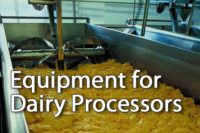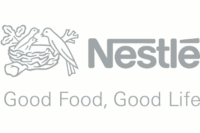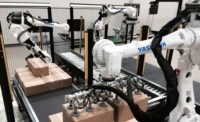For more than 60 years, Batavia, N.Y.-based O-At-Ka Milk Products has co-packed dairy-based products. One of O-At-Ka’s bright spots has been the growing demand for co-packed ready-to-drink (RTD) beverages such as milk-based coffees, teas, energy drinks, nutritional offerings and ethnic selections.
Recently, the company installed a new and innovative packaging line, boosting the plant’s practical operating capacity by 50% by utilizing a state-of-the-art sterilization process, an integrated high-speed/fast changeover can and bottle filling line, new labor practices and a focus on overall equipment effectiveness (OEE).
Exceeding past production volumes
O-At-Ka is owned by milk cooperatives Upstate Niagara Cooperative and Dairy Farmers of America and sources 90% of its dairy inputs from farms located within a 100-mile radius of its plant in Batavia. Sales are both national and international. O-At-Ka employs more than 450 employees.
With demand high for RTD beverages, the plant’s two existing specialty packaging lines were at capacity for canned and bottled products.
“One of the problems we had to face in terms of increasing production capacity was our lack of space,” says Eric Brooks, production manager. “We evaluated our site and designated a new addition of 20,000 square feet for a RTD packaging line. If we simply replicated what we had in that space, we would not meet our growth forecast. We needed to develop a RTD line that would increase volume per every square foot utilized.”
The solution for O-At-Ka turned out to be multifaceted:
-
A new-to-the-plant sterilization process that significantly reduces retort time and, therefore, increases volume.
-
A high-speed/fast-changeover filling and capping line that handles both cans and bottles.
-
An improvement to the manufacturing execution system (MES) that provides OEE-actionable data to plant personnel.
-
Cross-trained operation crews knowledgeable about every machine on the line.
Water-immersion retorts
Milk-based RTD beverages are shelf-stable grocery products that do not require refrigeration. The shelf-stable feature, brought about through the process of sterilization, lowers waste and increases the opportunity for sale compared to refrigerated dairy products, which have a short shelf life, higher risk of wastage and limited shelf space in refrigerated dairy cases.
The two installed automated packaging lines at O-At-Ka featured the steam-water-spray retort process, which relies on even temperature throughout the vessel to uniformly heat and sterilize the cans and bottles of milk-based RTD beverages. Milk-based beverages need to be heated evenly and in such a way that the milk in the drink does not scorch or burn.
As O-At-Ka contemplated equipping its new packaging line, one problem became apparent: The new 20,000 square-foot addition could house at most four steam-water-spray retorts, not enough equipment to boost production as much as needed.
Brooks and others visited Allpax, a ProMach brand and specialist in retort technology, in Covington, La. Allpax engineers proposed substituting steam-water-spray sterilization with water-immersion sterilization. In a water-immersion sterilization, cans and bottles are completely submerged in super-heated water rather than being heated by a steam/hot water spray.
“Submersion in super-heated water drives heat into the food product along the entire surface area of the package,” explains Scott Williams, vice president of sales for Allpax. “During submersion, our retort rotates the baskets, distributing heat quickly and uniformly throughout the bottles or cans. Water immersion has two results in this application — shorter cook time for more batches per day and high-quality taste through fast sterilization.”
Williams adds that a patented basket design holds packages firmly in place, leading to optimum package appearance through less abrasion during processing.
“The Allpax retort and automated loading and unloading technology impressed us in a number of ways,” says Mike Lerminiaux, continuous improvement manager for O-At-Ka. “The fact that Allpax features U.S. made, readily available replacement parts and controls was extremely important for our uptime goals. We liked the rugged yet simple design strategies that gave us confidence the system would be easy to use and have a long service life. Importantly, electronic records of every batch would facilitate our commitment to product traceability and compliance with Food Safety Modernization Act guidelines.”
Kelly Finch, senior director of technology and project management adds, “The Allpax virtual private network system of remote diagnostics and repair offered high security and fast problem resolution. We were impressed by the ease of the approach and also its security features.”
O-At-Ka subsequently ordered four water-immersion retorts and a fully automated loading and unloading system for its new line.
Layout of the new RTD line
The O-At-Ka multi-disciplinary team visited other manufacturers and designed a can and bottle packaging line that would meet key goals:
-
Run both cans and bottles.
-
Run at speeds capable of keeping the four retorts supplied with product.
-
Exhibit minimum change over time.
-
Operate with minimum labor.
The packaging line begins with a Busse depalletizer, which automatically unloads bulk pallets of 15-ounce cans or various-size glass bottles. Once unloaded, cans or bottles are conveyed via a lube-less conveyor, selected for its sanitary design, to a JBT hot/cold fill unit filler.
After filling and sealing, cans and bottles are routed to an Allpax automated system that removes all labor from the arduous task of loading and unloading baskets, moving baskets to and from the retorts, and loading and unloading the retorts. In addition to labor savings, automation also serves as a safety feature. An automated basket tracking system ensures that the right load goes to the assigned retort. The system alarm will signal should any basket deviate from its designated processing path.
Following sterilization, preprinted cans are routed to a Douglas case packer. Cans and bottles requiring a full-body sleeve label are routed to a Pro Mach brand — Axon — sleeve applicator and then to the Douglas case packer. Bottles and cans, depending on the customer, may also be routed to the Pro Mach brand PE press-and-apply labeler with automatic roll changeover and built-in redundancy. The PE labeler applies front and back labels. Bottles and cans move via conveyor to the case packer, which is located in another room at the plant due to space considerations.
A new approach to labor
O-At-Ka negotiated with the union representing production and maintenance personnel for a new approach to assignments. Rather than having a member of the production team specializing and becoming an expert on one machine, O-At-Ka proposed having personnel on the new line cross-trained on every machine.
A six-person cross-trained crew is responsible for production on each shift. At any given time, there is an operator for the retort, an operator for basket handling automation and one each for the filler, labeler and case packer. The sixth relief operator floats among the various positions.
This approach maximizes team assignment flexibility and, importantly, expands the knowledge base for diagnosing and fixing production problems. A cross-trained crew also gives the team greater flexibility to adapt to illness, vacation and personal issues.
“Cross-training has been so successful we’ve taken it to other areas of the plant,” Lerminiaux says.
Insights into the process
“One of the goals we focused on for the new line was obtaining greater visibility and understanding into actual conditions,” says Finch. “When there is a slowdown on the line, we now can access information that identifies the true cause of the problem either upstream or downstream of the machine in question, not the apparent cause of the slowdown.”
She went on to say, “Every piece of equipment in the new line, conveyors included, provides us with information we can see in terms of stoppages. This visibility is not because a user inputted it, but because the control system is telling our MES that there was downtime, and it is associated with this or that asset. This is an extremely powerful and important tool for production optimization.”
Many of the lessons learned on the new RTD line are being applied both to new and existing installations. Finch, Lerminiaux and Brooks all agree that the new RTD line served to raise O-At-Ka’s understanding of how to apply new generations of automation technology.








